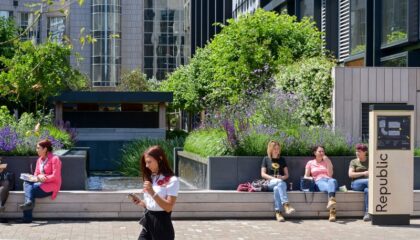By now we all know the race to Net Zero is a marathon, not a sprint although there are 10 hurdles that are most achievable and effective to clear, as outlined by Hedley Jones, Partner, Head of ESG Refurbishment & Development.
Here we reveal the top 10 steps in the race for Net Zero buildings which should be at the top of your to-do list for 2023…
1. Switch to LED for high-energy savings
Lighting accounts for almost 5% of global CO2 emissions but switching to LED lighting achieves energy savings of between 50% to 70% compared to old technologies, says the Climate Group. A global switch to energy efficient LED could save more than 1,400 million tonnes of CO2 and avoid the construction of 1250 power stations. Even further efficiencies can be made by using daylight-dimming options where there is good natural light and smart technology to ensure that only those areas with occupants are active.
2. Harness technology for intelligent buildings
Cloud-based, internet-of-things (IoT)-linked intelligent building technologies are proving a vital tool in the journey to Net Zero. Smart cities that feature intelligent smart building operating systems could achieve up to 50% savings in existing buildings that are otherwise inefficient. Workman’s IBOS utilises information gained from existing building services in real time, gathered remotely, and feeds into a dashboard showing round-the-clock energy usage to help inform decisions around addressing Net Zero ratings.
3. Remove gas boilers for energy efficiency
As part of its latest report, ‘Whole Life Carbon Roadmap: A Pathway to Net Zero,’ the UKGBC sets out several key policy recommendations for government. One of these is the introduction and clear signalling of a cut-off date of 2030 for the sale of gas and oil boilers. In order to get ahead of this kind of regulation, it’s imperative the building owners take advantage of their next refurbishment in order to reassess heating, cooling and hot water generation. This can be made more efficient with the introduction of energy-efficient plant such as air-source heat pumps.
4. Introduce on-site renewables for clean power
Installing on-site renewables such as solar PV helps reduce purchased grid energy. When used in combination with green roofs, the efficiency of solar panels can be further enhanced through a cooling effect. Running enhanced energy modelling will test the viability of clean power solutions for carbon-emissions reductions and alternative designs. This is especially important, because the energy supply sector is the largest contributor to global greenhouse gas emissions, responsible for around 35% of total emissions, according to the IPCC (Intergovernmental Panel on Climate Change).
5. Refurbish and reuse for longer-life-cycle buildings
By element, the largest contributor to embodied carbon is the substructure and superstructure. This accounts for 65% of a typical office, according to LETI (the London Energy Transformation Initiative). When considering redevelopment options, a comprehensive understanding of these aspects is necessary so that it’s clear whether new designs can be efficiently developed around the existing frame.
Avoiding demolition cuts waste and the introduction of carbon into new structures, as well as the carbon impacts and local disruption from transport. This also shortens construction programmes. The potential carbon impact of reuse and refurbishment could prove significant, as opposed to simply creating more new buildings.
6. Select recycled materials for a circular economy
Selecting materials with higher recycled content can make a big difference. The carbon impact from raw material extraction is only counted the first time the material is processed. After that, the recycled material includes only the impacts from its reprocessing. This strategy has the added value of keeping materials inside the economy and reducing the pressure for extraction of virgin materials. It also reduces negative financial and environmental factors around waste and landfill.
7. Use fewer finishes for greater accessibility and reduced wastage
Finishes are among the elements that have the shortest lifespans in commercial buildings, which are often reconfigured. The aggregated impact of replacing these elements several times during the lifecycle of a building can have a significant overall impact on waste and carbon footprint. However, opting for an exposed services approach allows the omission of suspended ceilings, which reduces the initial carbon impact as well as throughout the life cycle during maintenance and refurbishment work. This also makes services more accessible for maintenance and alteration.
8. Choose low carbon materials for lower embodied-carbon
The use of more natural, low-carbon materials such as cross-laminated timber (CLT) or mass timber products can result in quicker and cleaner construction than traditional builds, with a lower embodied-carbon footprint. It’s also a lighter material, resulting in a potentially lighter structural frame and foundations. A recent study by the University of Washington concluded that a CLT building “could achieve a 26% reduction in global warming potential.” However, it requires consideration from both an acoustics and fire strategy perspective, as well as the avoidance of binding agents that contain volatile organic compounds (VOCs).
9. Promote active commuting for a smaller carbon footprint
A global transition to zero-emission transport is a priority, since transportation is estimated to account for 20% of global emissions each year, so it’s wise to investigate how people are getting to and from the building. Cycle-to-work schemes, and modern cycling facilities should be provided as an encouragement to cycle, as the average person can save 6% of their annual carbon footprint by making this switch.
Given the government’s plan to ban the sale of new petrol and diesel cars from 2030, installing electric car facilities will become a priority. In the first half of 2021, electric cars accounted for 7.2% of sales – up from 4% during the same period in 2020, according to What Car? The shift to electric vehicles is especially critical as transport accounts for a quarter of the UK’s total carbon dioxide emissions.
10. Keep supply chains short for reduced air pollution
Transportation is the main cause of air pollution in cities, according to the European Commission. A focus on supply chains local to the construction site can reduce transport carbon. By procuring from local sources where possible, the emissions during transportation fall, and the local economy is supported. The mode of transport is also important, as transport by road is far more carbon-intensive than transport by rail, but rail is more carbon-intensive than transport by sea.
Want to know more?
Read more about our Net Zero Asset Plans
Read more here about our ESG services and our ESG Project Advisor service



